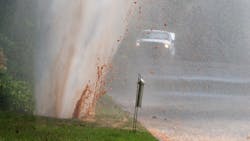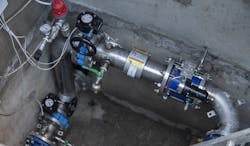New Approach to Pipe Burst Prevention is Welcome for Utilities
On May 7, 2022, eight million gallons of water flooded one of the largest east-west highways in the United States. A water main had broken in Tempe, Ariz.--13 feet beneath U.S. 60. Both lanes of this major artery were closed for more than a week.
On June 14, a main break in Odessa, Texas, caused the city’s entire network to lose pressure. One hundred and sixty-five thousand people lost access to potable water for almost two full days, as temperatures soared to 100°F outside. The emergency forced businesses, schools, and public agencies to close.
Similar events have happened recently in Syracuse, N.Y. And Hollywood, Calif. And Newark, N.J. In St. Louis Park, Minn., the same water main flooded the same set of unhappy homeowners twice in two weeks. But except for the most dramatic threats to life and property, water main breaks have almost lost their capacity to surprise.
According to the American Water Works Association (AWWA), a water main ruptures somewhere in the United States about every two minutes. Major cities can count on about 25 breaks a year for every 100 miles of pipe in their networks--and things are getting worse. A 2018 study by Utah State University found that in the U.S. and Canada, the incidence of breaks had risen by 27% in the prior six years. With infrastructure aging fast and funds for replacement in short supply, utilities are scrambling to keep up with a literal financial drain.
Fortunately, however, new solutions may be at hand. With sophisticated pressure management valves from manufacturers such as GF Piping Systems, utility managers can alleviate some of the strain on their systems—before they find themselves starring on the evening news.
Networks in Need
By and large, Americans can take a steady supply of safe water for granted—and usually do. However, a crisis point is approaching, as the many miles of new water main laid down in the United States just after World War II begin to near the end of their expected 75- to 100-year lifespan. Some water mains still in service in the U.S. date back much farther, to the days of the Civil War.
Despite calls from AWWA for a new “replacement era,” plans for renewal of these aging networks have been slow to materialize. With federal spending on water infrastructure drastically reduced over the past 40 years, the US Water Alliance estimated the gap between needed investment and actual expenditure at $81 billion for the year 2019. As metal pipes obey the laws of nature and continue to deteriorate, AWWA predicts that over $1.7 trillion in water infrastructure investment will be needed in the U.S by 2050.
Resources Down the Drain
This rate of water main breakage clearly has far-reaching effects: members of the public may experience anything from temporary inconvenience to property damage to serious threats to their health and safety. But even the financial consequences faced by utilities—and ultimately, by ratepayers—are heavy enough to be burdensome.
First, there is the obvious need for emergency response to gushing pipes—American Water, the utility serving Camden. N. J., recently estimated the cost of such unplanned repairs at $4,000 each. But beyond the costs of constant repair work, utilities must also withstand substantial losses in the form of lost water. For the year 2019, the US Water Alliance estimated the value of the treated water lost to leakage in the United States at $7.6 billion.
Outright replacement of aging pipes might be the most straightforward approach to this situation. Metal piping will inevitably thin over time due to corrosion, and weaker pipes are more vulnerable to rupture. However, when surveyed in 2017, only 58% of water utilities in the U.S. and Canada reported having a regular pipe replacement program, and those who did planned to replace less than 1% of their installed length each year.
Fortunately, it is also possible to address the other side of the equation. While utilities may be limited in how much they can lower their overall water pressure, variability in pressure stresses fragile pipes as well. When pressures change frequently, the resulting expansion and contraction of the piping causes microfractures that can lead to future breaks. Pressure stabilization is thus a highly attractive option for utilities—and one that they may now be able to execute within budget.
Taking the Pressure Off
One tale of success comes from Italy, where the rate of water loss from distribution networks is believed to be as high as 37%. Given the recent impact of climate change on the region in the form of severe droughts, protection of the water supply has taken on a new urgency.
IRETI is the water utility that serves approximately 2.8 million residents of northern Italy, covering 242 municipalities in the regions of Emilia-Romagna, Liguria, and Piedmont. In 2019, IRETI sold over 180 million cubic meters of water, using more than 20,000 kilometers of aqueduct.
To implement this strategy, IRETI decided to install NeoFlow Pressure Regulating Valves from GF Piping Systems. NeoFlow PRVs will maintain downstream pressure at the desired, preset level regardless of the upstream pressure or any flow rate fluctuations. The valves deliver extreme precision and stability of pressure over the full range from 1% to 100% opening.
Dramatic Turnaround
One year later, IRETI was able to report dramatic results from the NeoFlow installation. With pressures stabilized, mechanical stress on the system has been reduced, and so has the breakage rate. “Thanks to pressure management, we have been able to achieve a 63% reduction in pipe bursts,” stated Antonio Gualtieri, IRETI’s Technical Manager for Water Leakage Detection.
IRETI has also benefited in other respects from its decision to install NeoFlow. For one thing, NeoFlow’s lightweight polymer construction helped the retrofit process itself to go quickly and smoothly. Up to 5 times more compact and 9 times lighter than traditional metal PRVs, NeoFlow valves require 40% less time to install. The valves can be handled by a single operator, and they are easier to fit into tight spaces. Space savings may also allow measurement equipment to be installed directly next to the outgoing flow without causing problems for accuracy.
NeoFlow also offered IRETI a reduction in ongoing maintenance costs. Since they are made of polymer rather than metal, the valves are not subject to corrosion. When maintenance is required, it can be completed in under an hour. NeoFlow PRVs also use a simple, axial flow design, with only three primary components—the casing, the piston, and the core—with no actuator stem or diaphragm. This simplicity (with only one moving part) offers greater reliability and a longer operational lifespan.
Turning Back the Clock
For utility managers who may have wished they could turn back time, pressure management seems to offer the next best thing. In the words of Oliver Narbey, Senior Business Development Manager at GF Piping Systems: “You have to think of it as a kind of anti-aging treatment for water networks.”
The hard questions posed by aging infrastructure defy easy resolution. The challenges of water conservation are similarly daunting, and no single technology is likely to provide a complete answer. But for water utilities caught in a cycle of endless pipe bursts and endless repairs, any addition to the toolbox is welcome indeed. Describing his successful experience with NeoFlow, IRETI’s Gualteri noted: “We hope to see more products that are as innovative, and above all, as reliable as this one.” Utility professionals everywhere can only agree.
About the Author
Katherine Bonamo
Katherine Bonamo writes on architecture, building, construction and other engineering topics for publications throughout the United States.



